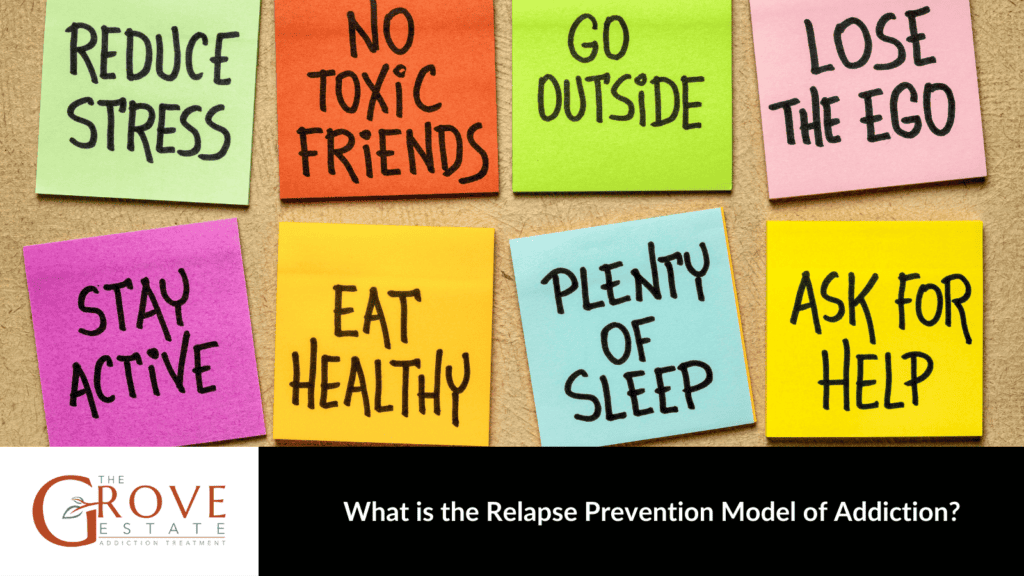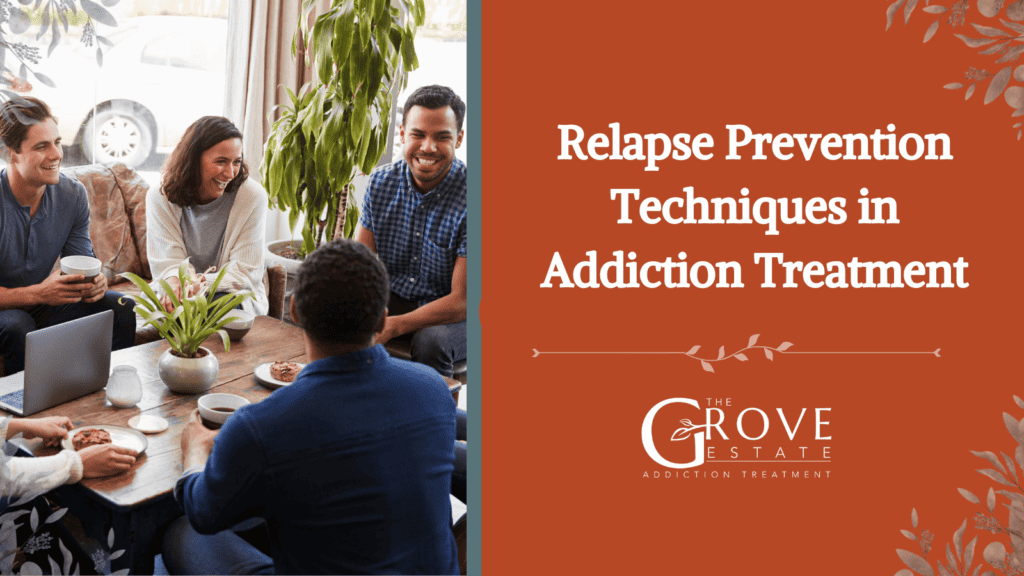Addiction is a relentless adversary that casts a long shadow over an individual’s life, affecting not only their physical health but also their relationships, aspirations, and overall well-being. Breaking free from addiction is an extraordinary achievement, but the journey doesn’t end with sobriety. To safeguard their newfound freedom, individuals must navigate the challenges of relapse prevention.
Relapse prevention techniques are strategies to maintain recovery from addiction. These include identifying triggers, learning coping skills, developing a support network, creating a relapse prevention plan, avoiding high-risk situations, prioritizing self-care, seeking professional help when needed, and staying vigilant. These techniques help individuals manage cravings and reduce the risk of returning to substance use, promoting a healthier and more stable life in recovery.

What is the Relapse Prevention Model of Addiction?
The Relapse Prevention Model of addiction is a behavioral approach developed to help individuals with addictive behaviors avoid relapse or a return to these behaviors. This model was primarily developed by psychologists G. Alan Marlatt and Judith Gordon in the 1980s. It’s based on the principles of cognitive-behavioral therapy (CBT) and emphasizes the need for self-management and coping strategies to prevent the recurrence of addictive behaviors.
Key components of the Relapse Prevention Model include:
- Self-Management: Teaching individuals how to manage their behavior and make lifestyle changes that support recovery.
- Coping Strategies: Developing skills to handle high-risk situations, emotional triggers, and stress without reverting to addictive behaviors.
- Lifestyle Modification: Encouraging lifestyle changes to reduce the risk of relapse, such as engaging in healthy activities and building a supportive social network.
- Cognitive Processes: Addressing cognitive patterns that can lead to relapse, such as denial, irrational thinking, and a lack of awareness of one’s triggers.
What Type of Therapy is Relapse Prevention?
Relapse Prevention is a form of therapy that integrates the principles of cognitive-behavioral therapy (CBT) and is specifically tailored to aid individuals in recovery from addiction. This approach focuses on identifying and managing triggers and high-risk situations that could lead to a relapse. This therapy can be administered in both individual and group settings and is a crucial component of comprehensive addiction treatment programs. Its evidence-based strategies are effective in helping individuals maintain long-term recovery from addiction.
What Are The Techniques To Prevent Relapse?
Relapse Prevention Techniques encompass a range of strategies and practices aimed at maintaining long-term recovery and preventing a return to addictive behaviors.
1. Cognitive Therapy
This therapy involves identifying and changing negative thought patterns, beliefs, and attitudes. It helps individuals recognize distortions in their thinking that are creating problems, and then to reevaluate them in light of reality.
2. HALT; Hungry, Angry, Lonely, and Tired
This technique reminds individuals to halt and assess their feelings. If they are Hungry, Angry, Lonely, or Tired, they are more susceptible to negative behaviors, including relapse. Addressing these basic needs helps maintain emotional and physical stability.
3. Self-awareness, Know What Triggers You
This involves understanding the personal triggers that lead to negative behaviors or thoughts. By being aware of these triggers, individuals can develop strategies to avoid them or cope with them more effectively.
4. Self-care
This is the practice of taking action to preserve or improve one’s own health. This includes physical self-care, like eating healthy and exercising, and emotional self-care, such as engaging in hobbies and connecting with loved ones.
5. Practice Mindful Meditation
Mindful meditation involves paying attention to the present moment without judgment. It helps in managing stress, improving concentration, and gaining a better understanding of one’s thoughts and feelings.
6. Join a Support Group
Support groups provide a space for sharing experiences and receiving empathy and encouragement from others who are facing similar challenges, which can be incredibly beneficial in maintaining mental health and preventing relapse.
7. Deep Breathing Exercises
Deep breathing is a simple, yet effective, method for reducing stress, anxiety, and managing impulses. It involves consciously slowing and deepening your breath, which can help calm the mind and body.
8. Grounding Techniques
These techniques are used to bring someone back in touch with the present moment. They are particularly useful in managing overwhelming emotions or anxiety and can include tactics like focusing on sensory experiences or engaging in physical activity.
9. Think of the Consequences
This involves considering the potential negative outcomes of a particular behavior before acting. It can serve as a deterrent to engaging in harmful behaviors by reminding individuals of the long-term impacts.
10. Make an Emergency Contact List
Having a list of people to contact in times of crisis can provide a sense of security. This list includes friends, family members, therapists, or members of a support group, who can offer immediate support and guidance.

What Are The Stages of Relapse?
Relapse in addiction recovery is not a singular event but a process that occurs in stages. Understanding these stages is crucial for preventing a return to addictive behaviors. The stages of relapse are generally categorized as follows:
Emotional Relapse
During this stage, individuals are not actively thinking about using again, but their emotions and behaviors may be setting them up for a future relapse. Signs of emotional relapse include anxiety, mood swings, isolation, not attending support group meetings, poor sleep habits, and a refusal to discuss personal problems. The primary focus of this stage is on self-care to prevent progression to the next stage.
Mental Relapse
In this phase, there’s an internal struggle between a desire to use and a desire to remain abstinent. Signs include craving for drugs or alcohol, thinking about people and places associated with past use, minimizing the consequences of past use, bargaining, lying, thinking of ways to better control using, and planning for relapse. The key in this stage is for individuals to recognize these signs and seek help.
Physical Relapse
This is the stage where the individual starts using the substance again. It can be a one-time lapse, or it can lead to a full-blown relapse where the individual returns to uncontrolled use. Physical relapse is often harder to recover from due to feelings of guilt and failure, and the reinstated patterns of addictive behavior.
What Are Relapse Triggers and Common Causes of Relapse?
Relapse triggers are specific stimuli or situations that increase the risk of a person returning to addictive behaviors after a period of abstinence. Understanding and identifying these triggers is a critical aspect of relapse prevention. Common causes of relapse include:
- Stress: One of the most common triggers, as it leads to seeking relief through old habits.
- Exposure to Drugs or Alcohol: Being in the presence of substances one was addicted to can reignite cravings.
- Negative Emotional States: Feelings like sadness, loneliness, frustration, or anger can drive individuals toward substance use as a coping mechanism.
- Positive Emotional States: Conversely, positive emotions or celebrations can also trigger relapse, as individuals may feel they can control their substance use in a good mood.
- Peer Pressure: Social situations or being around others who use drugs or alcohol can increase the temptation to relapse.
- Conflict with Others: Arguments or relationship issues can trigger emotional distress, leading to substance use as an escape.
- Cues or Reminders of Addiction: Certain environments, smells, sounds, or even specific times of the year can serve as reminders of substance use and trigger cravings.
- Physical Pain or Discomfort: Some may revert to substance use as a way to manage physical pain or discomfort.
- Mental Health Issues: Co-occurring mental health disorders like depression or anxiety can exacerbate the risk of relapse.
- Complacency: Sometimes, feeling overconfident in one’s recovery can lead to letting one’s guard down and not maintaining active coping strategies.
What Are The Benefits of Relapse Prevention Programs?
Relapse prevention plays a crucial role in the journey of recovery from addiction, offering a multitude of benefits that extend beyond simply avoiding a return to substance use. At its core, it significantly reduces the risk of relapse by equipping individuals with the knowledge and skills to identify and manage potential triggers. This process inherently improves coping skills, teaching healthier and more effective ways to deal with stress, cravings, and negative emotions. An essential component of this approach is the enhancement of self-awareness. Individuals become more attuned to their personal patterns related to addiction, including specific triggers and behaviors, which is a vital aspect of sustained recovery.
Additionally, relapse prevention aids in better emotional regulation, providing tools and strategies to handle emotional distress without resorting to substance use. This leads to an increased sense of control over one’s life and decisions. Participants often find that through engaging in relapse prevention techniques, they not only maintain sobriety but also experience overall improvements in their well-being and quality of life.

What Are Some Relapse Warning Signs?
Warning signs of relapse are crucial indicators that help individuals and their support networks identify potential risks and take preventive action to maintain sobriety. Some common relapse warning signs include:
- Increased Stress: Feeling overwhelmed or constantly under pressure.
- Isolation: Withdrawing from friends, family, or support networks.
- Changes in Attitude: Losing interest in recovery or feeling complacent.
- Revisiting Old Habits: Returning to places or people associated with past substance use.
- Neglecting Self-Care: Poor eating, sleeping habits, or neglecting personal hygiene.
- Mental Health Fluctuations: Experiencing heightened anxiety, depression, or mood swings.
- Romanticizing Past Use: Recalling substance use as more positive than it was.
- Defensiveness: Becoming defensive or angry when discussing sobriety.
- Poor Judgment: Making decisions that put one at risk of using.
- Craving Substances: Experiencing an increased desire to use again.
How to Make a Relapse Prevention Plan
A well-thought-out relapse prevention plan is a dynamic tool that evolves with an individual’s recovery journey and provides a roadmap for maintaining sobriety and handling challenges effectively.
Identifying Personal Triggers for Relapse
Recognizing situations, emotions, people, or places that might increase the risk of returning to unhealthy behavior, is important to avoid relapse. This could include stress, certain social settings, or specific times of the year. For each identified trigger, develop a specific plan on how to handle it. This may involve techniques like deep breathing, mindfulness, or seeking support from a friend or counselor.
Strategies for Coping with Cravings and High-Risk Situations
Many strategies help to avoid relapse including:
- Identifying Triggers: Think about what to do in unexpected high-risk situations.
- Make a plan: Having a clear plan can help avoid spontaneous decisions that might lead to relapse
- Healthy Habits: Establish a healthy routine and incorporate regular exercise, a balanced diet, adequate sleep, and time for hobbies or activities that promote well-being.
- Peer Support: Build a support network by including contact information for supportive family members, friends, therapists, or support group members who can be reached out to in times of need.
- Set Short and Long-Term Goals: Having goals related to personal growth, career, education, or hobbies can provide direction and a sense of purpose.
- Practice Self-Care: Regularly engage in activities that promote mental and physical health, like meditation, reading, or other relaxing hobbies.
- Monitor Mental Health: Be aware of signs of depression, anxiety, or other mental health issues and seek professional help if needed.
- Review and Revise the Plan Regularly: As circumstances and individual needs change, it’s important to update the plan to remain relevant and effective.
- Emergency Plan: Include a section for what to do in case of a lapse, such as who to call, where to go for help, and how to get back on track.
Success of Relapse Prevention Techniques
Relapse prevention is not just about avoiding substance use; it’s about improving coping skills, enhancing quality of life, and fostering a sustainable, healthy lifestyle that supports long-term recovery. Regular evaluation and adaptation of these techniques are critical to meet the evolving needs of individuals in their journey of recovery.
Perhaps the most significant measure of success is the ability to maintain long-term sobriety. Ongoing abstinence from substance use over an extended period is a strong indicator of the effectiveness of relapse prevention techniques.

Where To Find A Successful Relapse Prevention Program?
The success of relapse prevention techniques is evident not just in the reduction of relapse incidents but also in the improved quality of life, increased self-efficacy, and the establishment of long-term healthy habits among individuals in recovery. Regular evaluation and adaptation of relapse prevention strategies ensure they remain responsive to the changing needs of those on the path to recovery. Ultimately, Relapse Prevention Techniques play an invaluable role in supporting individuals to lead fulfilling lives, free from the constraints of addiction.
Take the next step towards a healthier, more fulfilling life with a continuing relapse prevention program. The Grove Estate in Indiana offers a comprehensive relapse prevention program that starts at the beginning of treatment in the Indiana medical detox program. Don’t let addiction define your story. Reach out today to learn more and start your journey towards a brighter, substance-free future.

Share This Post



